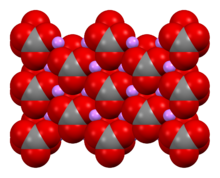User:Mr. Ibrahem/Lithium (medication)
 | |
 | |
| Clinical data | |
|---|---|
| Trade names | Many[1] |
| AHFS/Drugs.com | Monograph |
| MedlinePlus | a681039 |
| License data | |
| Pregnancy category |
|
| Routes of administration | By mouth, parenteral |
| Drug class | Mood stabilizer |
| Legal status | |
| Legal status | |
| Pharmacokinetic data | |
| Bioavailability | depends on formulation |
| Protein binding | None |
| Metabolism | Kidney |
| Elimination half-life | 24 h, 36 h (elderly)[2] |
| Excretion | >95% kidney |
| Identifiers | |
| |
| Chemical and physical data | |
| Formula | Li+ |
| Molar mass | 6.941 g/mol |
| 3D model (JSmol) | |
| |
| |
Lithium compounds, also known as lithium salts, are primarily used as a psychiatric medication.[2] It is primarily used to treat bipolar disorder and treat major depressive disorder that does not improve following the use of antidepressants.[2] In these disorders, it reduces the risk of suicide.[4] Lithium is taken by mouth.[2]
Common side effects include increased urination, shakiness of the hands, and increased thirst.[2] Serious side effects include hypothyroidism, diabetes insipidus, and lithium toxicity.[2] Blood level monitoring is recommended to decrease the risk of potential toxicity.[2] If levels become too high, diarrhea, vomiting, poor coordination, sleepiness, and ringing in the ears may occur.[2] If used during pregnancy, lithium can cause problems in the baby.[2] It appears to be safe to use while breastfeeding.[5] Lithium salts are classified as mood stabilizers.[2] How lithium works is not specifically known.[2]
In the nineteenth century, lithium was used in people who had gout, epilepsy, and cancer.[6] Its use in the treatment of mental disorders began in 1948 by John Cade in Australia.[6] It is on the World Health Organization's List of Essential Medicines.[7] It is available as a generic medication.[2] The wholesale cost in the developing world in 2014 was between US$0.12 and US$0.20 per day.[8] In the United States at usual doses it costs about US$0.90 to US$1.20 per day.[2] In 2017, it was the 180th most commonly prescribed medication in the United States, with more than three million prescriptions.[9][10]
References[edit]
- ^ "Lithium brands". Drugs.com. Archived from the original on 5 April 2017. Retrieved 4 April 2017.
- ^ a b c d e f g h i j k l m n o "Lithium Salts". The American Society of Health-System Pharmacists. Archived from the original on 2015-12-08. Retrieved Dec 1, 2015.
- ^ "WHOCC - ATC/DDD Index". www.whocc.no. Archived from the original on 6 August 2020. Retrieved 22 September 2020.
- ^ Cipriani, A; Hawton, K; Stockton, S; Geddes, JR (27 June 2013). "Lithium in the prevention of suicide in mood disorders: updated systematic review and meta-analysis". BMJ (Clinical Research Ed.). 346: f3646. doi:10.1136/bmj.f3646. PMID 23814104. Archived from the original on 7 May 2018. Retrieved 7 May 2018.
- ^ "Lithium use while Breastfeeding". LactMed. 2015-03-10. Archived from the original on 8 December 2015. Retrieved 1 December 2015.
- ^ a b Sneader, Walter (2005). Drug discovery : a history (Rev. and updated ed.). Chichester: Wiley. p. 63. ISBN 9780471899792. Archived from the original on 2017-09-08.
- ^ World Health Organization (2019). World Health Organization model list of essential medicines: 21st list 2019. Geneva: World Health Organization. hdl:10665/325771. WHO/MVP/EMP/IAU/2019.06. License: CC BY-NC-SA 3.0 IGO.
- ^ "Lithium Carbonate". International Drug Price Indicator Guide. Archived from the original on 22 January 2018. Retrieved 1 December 2015.
- ^ "The Top 300 of 2020". ClinCalc. Archived from the original on 12 February 2021. Retrieved 11 April 2020.
- ^ "Lithium - Drug Usage Statistics". ClinCalc. Archived from the original on 8 July 2020. Retrieved 11 April 2020.
